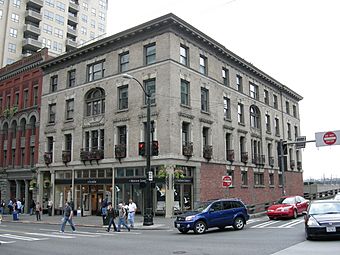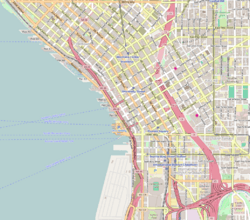Colonial Hotel (Seattle) facts for kids
Quick facts for kids |
|
|
Colonial Hotel
|
|

The Colonial Hotel, September 2007
|
|
| Location | 1119-1123 1st Ave., Seattle, Washington |
|---|---|
| Built | 1892, 1901 |
| Architect | Max Umbrecht |
| Architectural style | Federal Style |
| NRHP reference No. | 82004232 |
| Added to NRHP | April 29, 1982 |
The Colonial Hotel is an old and important building in Seattle, Washington. You can find it at 1119-1123 1st Avenue. It's right in the middle of the city's main business area.
Most of the building you see today was built in 1901. It was built on top of an earlier building from 1892-1893 that was never fully finished.
The hotel was built because many people came to Seattle during the Klondike Gold Rush. It was a place where people could rent a single room.
In the 1980s, the Colonial Hotel was fixed up and turned into apartments. It was also connected to the Grand Pacific Hotel next door.
Both buildings are now called the Colonial Grand Pacific. They were added to the National Register of Historic Places in 1982. This means they are officially recognized as important historical sites.
Contents
Building the Colonial Hotel
After the Great Seattle Fire in 1889, Seattle's business area started to grow quickly. Many new buildings were planned. However, the economy slowed down in 1891. This meant some buildings were not finished, and many empty lots remained.
The Starr Building was built in 1890. It stood alone on its block until more construction began in 1892.
The Kenyon Family's Plans
Jacob Gardner Kenyon was a traveling ventriloquist and magician. He first visited Seattle in the early 1880s. With the money he made from his shows, he bought several pieces of land on 1st Avenue.
After the Great Fire, the value of his land went way up. In 1892, Kenyon hired a famous architect named John Parkinson. Parkinson designed a six-story building for Kenyon's corner lot.
Construction started in July 1892. However, the work stopped many times. Only the first floor was completed. Kenyon said there wasn't enough demand for offices or rooms. He also wanted the building's foundation to settle.
Jacob Kenyon passed away in December 1892. He left his Seattle properties to his son, Benjamin Kenyon. Legal problems and a financial crisis in 1893 stopped the building from being finished for many years.
James Clise Completes the Hotel
In December 1900, a well-known Seattle businessman named James Clise bought the unfinished Kenyon Building. He paid $430,000 for it. Clise quickly planned to finish the building as a hotel. Seattle was booming again because of the Klondike Gold Rush.
Clise hired architect Max Umbrecht. Umbrecht designed the top three floors of the building. He chose a style called "Federal motif." This style likely inspired the hotel to be named the Colonial.
In 1906, Clise sold the hotel to Sigmund Aronson and Harold Preston. They bought it for $180,000.
The Colonial Hotel Today
In the mid-1960s, many small hotels in downtown Seattle were closing. But the Colonial Hotel was still in good shape and allowed to stay open.
In the late 1970s, the Colonial and other historic buildings nearby were restored. This work was part of a big project by Cornerstone Development Co. This company is part of Weyerhaeuser. The project mixed new buildings with old ones that were fixed up for homes.
During its restoration, the Colonial Hotel was connected to the Grand Pacific Hotel next door. The two buildings became known together as the Colonial Grand Pacific Apartments. The Colonial Hotel was officially listed on the National Register of Historic Places on May 13, 1982.


